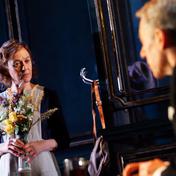Oxford Playhouse was built as a repertory theatre in 1938; the last new theatre to be constructed before the war.
The repertory years meant that a resident company of actors performed one play in the evenings whilst rehearsing the next during the day-times. The relentless schedule meant that audiences had the opportunity to see actors such as John Gielgud, Judi Dench, Ian McKellen, Ronnie Barker and Dirk Bogarde perform many roles on the Playhouse stage.
Perhaps the most famous production in the theatre’s history was an Oxford University Dramatic Society’s Dr Faustus in 1966. Alongside the student performers starred Richard Burton and Elizabeth Taylor, perhaps the most famous couple in the world at the time.
Other notable student performers over the years have included Rowan Atkinson, Michael Palin and Dudley Moore, and more recently, Emily Mortimer and Emilia Fox. Students who went on to success in other fields included politicians Shirley Williams and Nigel Lawson, director John Schlesinger and writers Alan Bennett and Christopher Hampton.
Though highly valued locally and held in national regard, the Playhouse often had a precarious financial position, and eventually closed in 1987 due to a lack of funds to carry out essential modernisation. Directors’ Hedda Beeby and Tish Francis were appointed to re-open the theatre, which they managed to do in 1991 after a long fundraising campaign and major refurbishment.
Since then, the theatre has gone from strength to strength, presenting a varied programme of high quality drama, dance, music, comedy, poetry and lectures. Though no longer a repertory theatre, the Playhouse is producing once again. See Oxford Playhouse Productions for more information.
A Longer History
An appeal to raise £25,000 to build Oxford Playhouse began in 1934, led by the young enthusiast Eric Dance when he joined the directors of the Oxford Repertory Company: Arthur Brough, Edward Wilkinson and Stanford Holme. In addition to the financial challenge, there was strong local objection to the building of a theatre, but the design of the façade by Sir Edward Maufe and theatre by F.G.M. Chancellor of the Frank Matcham & Co. firm of architects eventually silenced the opposition and building began on land leased by St John's College.
It was to be a home for The Oxford Players, who had been using the Red Barn on Woodstock Road (a former game museum with a reputation for uncomfortable seats and draughty conditions) for the previous 15 years.
Oxford Playhouse opened its doors on Beaumont Street on the 20th October 1938 with a glittering gala performance of JB Fagan's And So To Bed.
The War Years
During the war years the Playhouse survived and indeed to some extent thrived, as it attracted actors and directors who were unable to perform in London's closed theatres, but the early 1950s brought new financial problems for the director, Frank Shelley who ran the theatre in the actor manager tradition. He had helped to nurture the careers of many, including a young Maggie Smith and Ronnie Barker, but the company gave its last performance in April 1956.
Frank Hauser and The Meadow Players
Later that year a new chapter was opened when Frank Hauser took over and introduced The Meadow Players - a resident company that was to firmly establish the Playhouse as one of the nation's leading drama houses. Their first season saw 5 world premieres, 3 British premieres and set a standard for 18 years of producing which introduced European classics and employed many of the best actors of the time, such as Sybil Thorndike, Dirk Bogarde, Judi Dench and Ian McKellen.
Despite the artistic success of the Meadow Players, by the 1960s the Playhouse company was once again in debt and the theatre in urgent need of modernisation. In 1961 the University of Oxford purchased the lease of the theatre and work was undertaken under the first University Theatre administrator, Elizabeth Sweeting. The use of the theatre was shared between The Meadow Players and the numerous student and city drama groups, and during the 60s and early 70s the careers of countless performers and practitioners were launched. Returning to Oxford and his mentor Nevill Coghill, Richard Burton together with Elizabeth Taylor, famously appeared in the OUDS production of Dr Faustus in 1966. The couple's generosity initiated fundraising for the Playhouse workshop and The Burton Rooms - later to become the Burton Taylor studio theatre, which is an intimate space for student and professional drama, managed by the Playhouse.
Sadly in 1974 the Meadow Players folded due to mounting financial constraints but inspired by the success of the final "Summer Season" at the Playhouse, Elizabeth Sweeting and Gyles Brandreth established an Oxford Theatre Festival.
Anvil Productions
Later that year, Gordon McDougall formed Anvil Productions, the new Oxford Playhouse Company and with his co-director Nicolas Kent - and later Richard Williams - produced and toured a mixture of new plays, classics and comedies, notably Mephisto and Happy End (starring a young Bob Hoskins) But once again, despite last ditch appeals and rescue packages, with increasing costs, dwindling resources and the tightening of fire restrictions following the Bradford Stadium and Kings Cross rail disasters, the Playhouse was forced to close its doors in 1987.
During the closure years there were various strategic campaigns to save the building and a number of support groups continued to fight for its re-opening but it was not until May 1989 that the Oxford Playhouse Trust (set up by the University) was registered as an independent company; in July the same year it was awarded charitable status. Tish Francis and Hedda Beeby were appointed Joint Directors of the Playhouse in November 1989 and the following summer launched a phased £2 million appeal for the theatre's refurbishment and refitting. Work began on site in October 1990. £400,000 was raised in the first six months and the leases finally transferred to Oxford Playhouse Trust in 1991.
Into the Millennium
On 15th April 1991 the Playhouse re-opened with Geraldine Aaron's Same Old Moon, produced by Bridget Hayward's Theatre Division. Work was still in progress, however, with further funds needed to complete the first phase. Five years of campaigning raised a further £1.35m which, added to a Lottery award of £2.2m in 1995, funded major remodelling works.. During the summer of 1996 the seats were removed and replaced in continental configuration, the circle and bar re-built and air conditioning installed. A second National Lottery award in 1997 funded a further phase of work, which included the creation of a new rehearsal space and fire exits.
Over the past decade the Playhouse has built a reputation as one of Britain's leading theatres, presenting the best work from the national touring circuit, international theatre and increasingly producing, launching and commissioning new work. Its creative and producing ambitions were rewarded in 2001 when Arts Council England announced a phased £200,000 uplift as part of a nationwide re-investment in regional theatre taking effect from 2002.
If you are interested in Playhouse history, you might like to read Oxford Playhouse: High and Low Drama in a University City by Don Chapman, which gives a comprehensive account of the theatre's history. Don, former arts critic for the Oxford Mail and Oxford Times, has researched the Playhouse for more than a decade. His book was published in October 2008 by University of Hertfordshire Press to coincide with the Playhouse 70th Anniversary and is available, priced £19 from bookshops.
There are video and audio interviews on the BBC Oxford website, relating to Oxford Playhouse’s history, recorded to celebrate its 70th anniversary in 2008.









